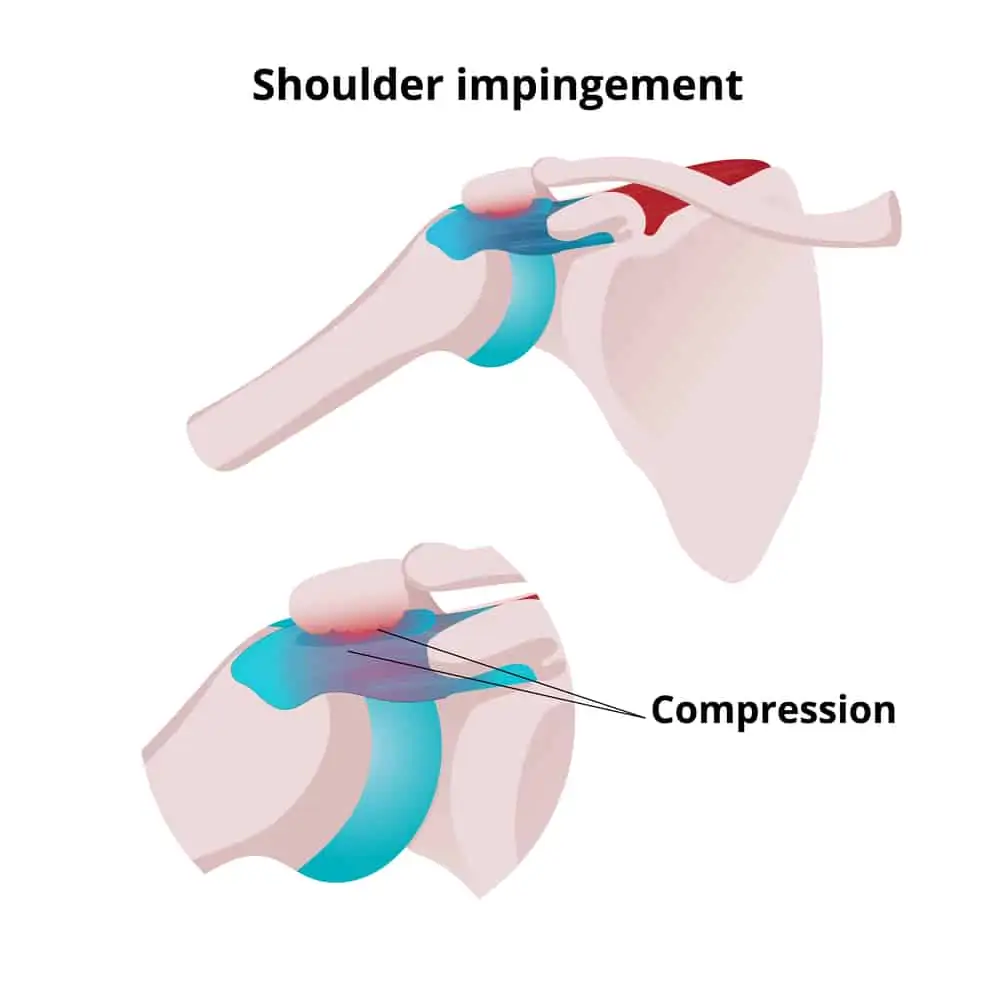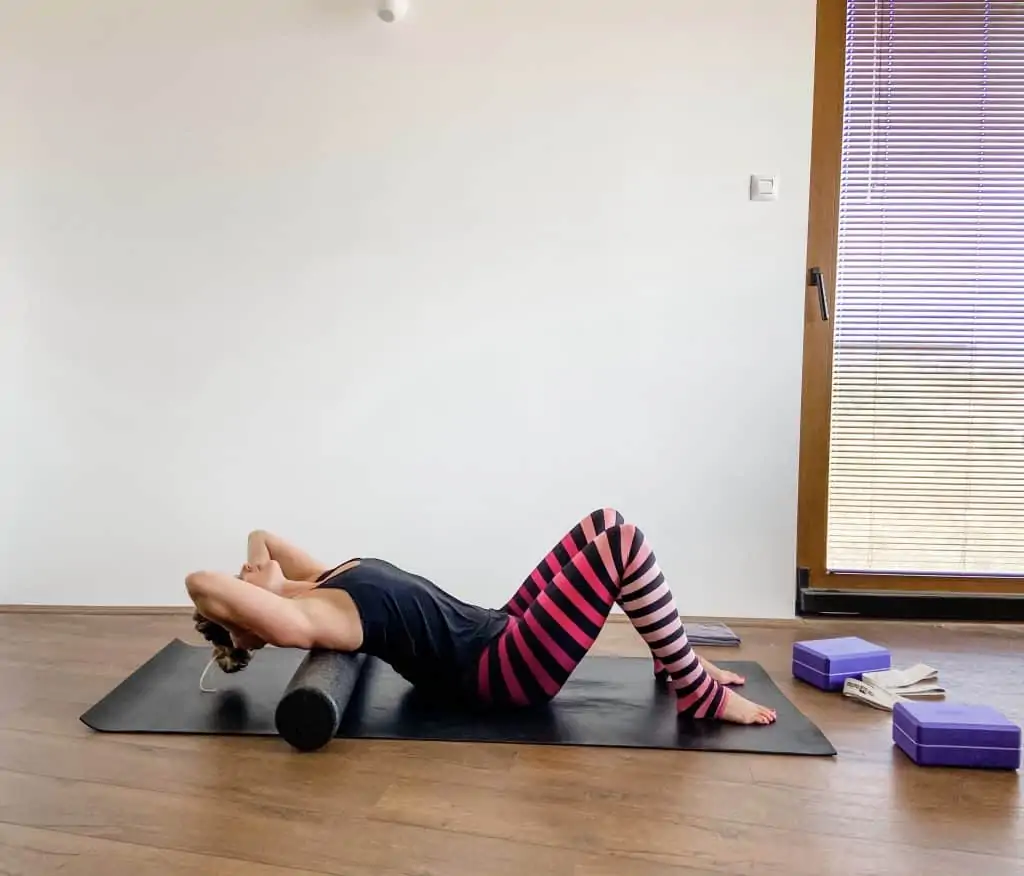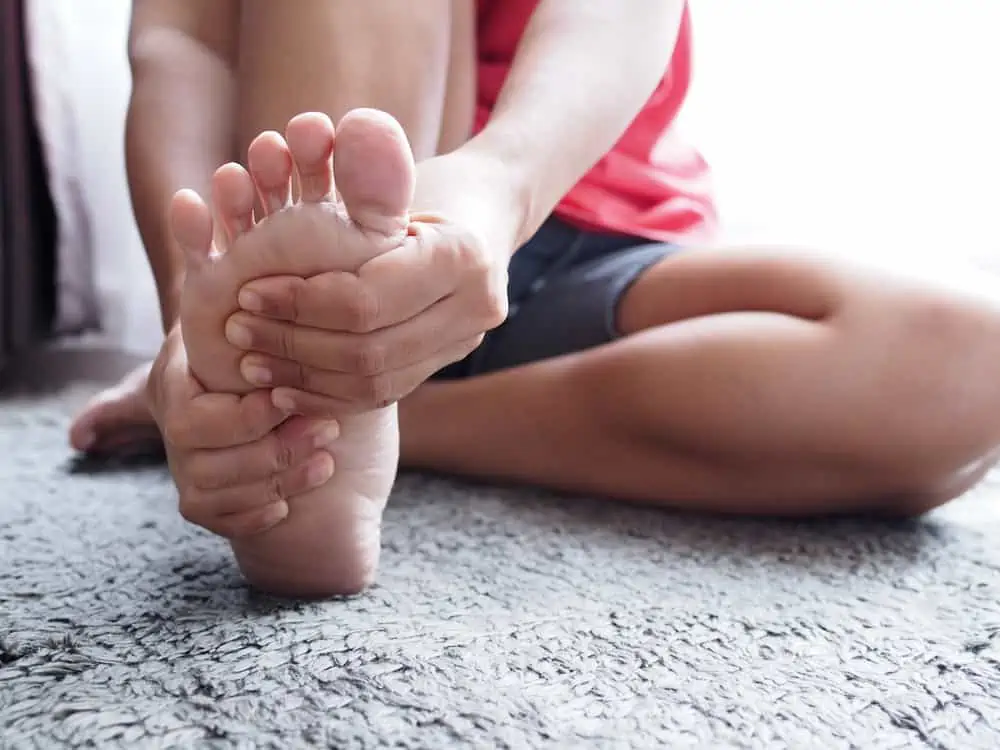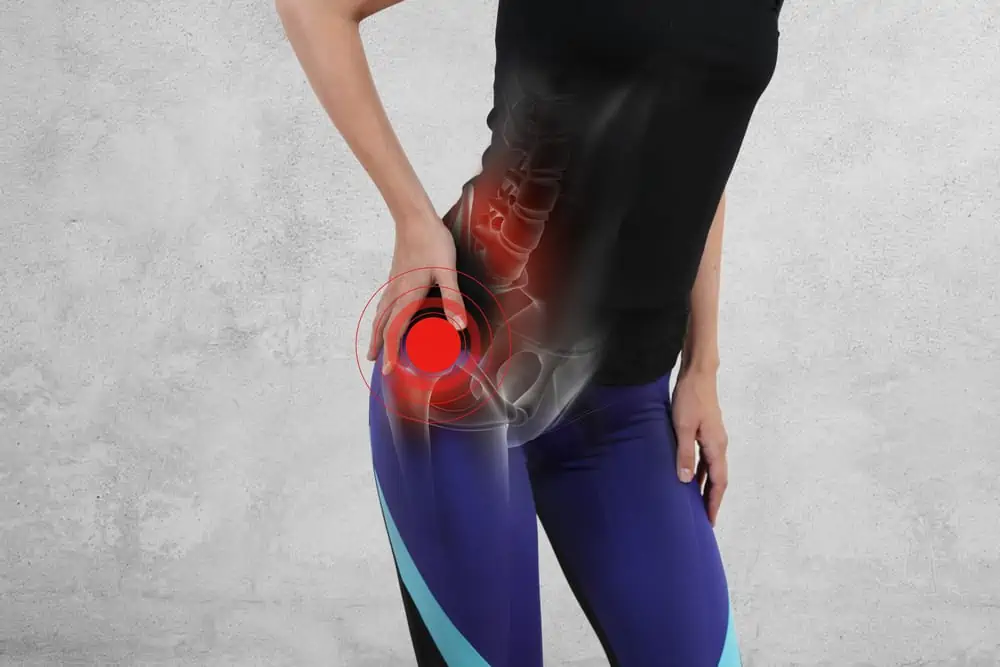This post may contain affiliate links. If you click through a link and make a purchase, I may receive a commission at no additional cost to you. As an Amazon Associate, I earn from qualifying purchases. Read the full disclosure here.
Shoulder pain can creep in anytime and stop you in your tracks.
If you’ve noticed shoulder pain reaching overhead, across your body, or behind your back when getting dressed, you may be experiencing shoulder impingement.
So how can you get better quickly and get back to life?
No worries, I got you. In this article, I’ll review impingement syndrome and the best rehab tools for home to start feeling better!
Disclaimer: This content is for educational purposes and is not medical advice. Read the full disclaimer.
What is shoulder impingement?
Shoulder tendonitis, rotator cuff tendonitis, rotator cuff impingement, subacromial impingement, and shoulder impingement syndrome are frequently used interchangeably to describe the same presentation.
Shoulder impingement syndrome is one of the most commonly reported complaints, accounting for approximately 44-65% of all shoulder pain complaints. (Tien J et al.)
The rotator cuff is four different muscles; supraspinatus, infraspinatus, subscapularis, and teres minor. Together they form the innermost layer of muscular stability to the shoulder.
When shoulder mechanics become altered (due to posture, overuse, injury, muscle weakness), the supraspinatus rotator cuff tendon can become pinched (impinged) between the humeral head (upper arm bone) and the arch of the acromion (which is attached to the shoulder blade) in certain positions.

Shoulder impingement can be tricky to conceptualize, leading many to feel frustrated trying to figure out why it only hurts sometimes. Rest assured, it isn’t random. It all has to do with the shoulder and motions that compress the supraspinatus tendon and cause pain.
To fix shoulder impingement pain, you need to know how the shoulder joint works so you can minimize those painful movements that stop you in your tracks.
Check out the video below that uses an easy-to-follow 3-dimensional model of the shoulder to explain this rotator cuff injury.
If left untreated, shoulder impingement can develop into frozen shoulder, which is a painful condition that includes joint stiffness, loss of range of motion, and shoulder function. Chronic impingement syndrome can also cause a rotator cuff tear over time.
What does shoulder impingement feel like?
- Intermittent or constant pain in the shoulder and/or upper arm
- The feeling of shoulder stiffness or loss of range of motion
- Pain that is worse with movement or at night
- Muscle weakness in the shoulder or arm
- Neck and upper back pain
- Difficulty reaching across your body, overhead, or behind your back
- Difficulty sleeping on the affected shoulder
Bursitis can be mistaken for shoulder impingement, or may also accompany rotator cuff tendinitis.
Best physical therapy tools for shoulder impingement pain
While shoulder pain can be scary, the good news is that physical therapy can be very successful at treating shoulder impingement. (Pieters L et al.)
To see the most success with rehab, you’ll also need to be diligent about doing your prescribed home exercises. Physical therapy isn’t something you get, it’s a process that you’re an integral part of.
Rest and other passive treatments like heat and massage alone do not fix impingement syndrome, so it’s crucial to get evaluated to start on the right track to healing your pain.
Here are some of the most recommended physical therapy tools for home to help with shoulder pain.
*Friendly PSA – these recommendations are not a substitute for getting a proper evaluation and a personalized home program. Not everything on this list may be right for you.*
Large ice packs
This isn’t your flimsy drug store ice pack. These clinical-grade ice packs come in the large sizes you’ll find at physical therapy.
My favorite is the Torex Mojility because they stay flexible even right out of the freezer. ColPac is another good brand with plenty of ice packs in similar sizes.
The cervical size (made for necks) is actually a great shape to fit like a horse-shoe over your shoulder. This size is also useful for wrapping around elbows, wrists, knees, and ankles.
You’ll never buy another teeny-tiny drug store ice pack again!
Pro tip: Always keep a towel or clothes layer between your skin and the ice pack to avoid skin burns.
Large hot packs
For chronic pain, some people prefer heat, especially for tight and painful muscles in the neck and upper back that accompany shoulder impingement pain.
Microwave hot packs are a quick and easy way to get some relief at home.
Pro tip: Always make sure you monitor your skin and use an appropriate layer of toweling or clothes to avoid burns.
Biofreeze
Bio freeze is a pain-relieving gel (it comes in a gel, roll on, and spray) that provides a cooling menthol sensation to decrease pain.
Biofreeze does not contain medication and can be a helpful adjunct to manage pain as you go about your day. It helps take the edge off.
Pro tip: this stuff is strong. Always make sure to wash your hands thoroughly after applying to avoid getting menthol in your eyes (or anywhere else). If applying the gel, you can also use a disposable glove to minimize any residue left after washing your hands.
(I think the roll-on style is the least messy of the three.)
Shoulder pulleys
If you’ve been to physical therapy for shoulder pain, you know what these are. Shoulder pulley exercises are a gentle way to restore pain-free range of motion after a shoulder injury.
When rehabbing shoulder impingement, you will need to perform home exercises several times per day. Physical therapists will often recommend that you get shoulder pulleys for home. Pulleys are inexpensive and anchor in a door frame.
The more consistent you are with your home program, the faster you will see results.

Pro tip – Don’t just quickly pump your arms back and forth willy nilly. The purpose of shoulder pulleys is to use one side to elevate the other in a pain-free range of motion passively. Move slowly and mindfully to relax the muscles and get further with less pain.
Less pain = more gain.
Sleeping wedge
Sleeping with shoulder impingement pain can be a living nightmare, and people often complain their sleep suffers significantly. Shoulder impingement often feels worse at night and finding a comfortable position can be exceptionally challenging.
Studies have predicted there is a reciprocal relationship between sleep and pain. The less quality sleep you get, the harder it is for the body to heal. Sleep deprivation plus pain is a very irritating combination.
Sleeping wedges and body pillows can help change the angle of your shoulder to improve comfort. The MedCline shoulder relief wedge and body pillow system is a unique answer to this problem.

Therabands
Strengthening the rotator cuff and upper back muscles should have a place in your rehab program to help the head of the humerus sit centered in the socket and avoid impingement with movement.
Therabands are an easy tool to accomplish many strengthening exercises as you progress in your rehab. They come in a variety of strengths to accommodate every level.
Shoulder pain can manifest from several different root causes, therefore the right exercises for you will depend on what’s causing your pain. For example, the exercises recommended for someone with shoulder pain due to shoulder instability will look different from those lacking shoulder and upper back mobility.
Pro tip: Ensure you understand how to perform your home exercises correctly, as poor technique can increase pain and set you back.
Foam roller
Foam rollers help shoulder impingement pain by allowing you to release tight muscles around the shoulder that might be affecting your range of motion, such as the lats and pec muscles.
You can also perform a variety of shoulder and upper back mobility exercises using a foam roller.
Upper back mobility, especially into extension and rotation, is necessary for healthy function of the shoulder.

Lumbar support cushion
You might be wondering what a lumbar support cushion has to do with shoulder pain, and the answer is everything!
Posture significantly affects the positioning of the shoulder. If you spend long hours working at a computer with poor posture, it can worsen existing shoulder pain (or cause new pain).
Massage gun
Massage guns are gaining popularity in the fitness world as people look for easy ways to help manage muscle pain at home.
Massages alone don’t fix shoulder impingement. However, shoulder pain is frequently accompanied by neck and upper back pain. Trigger points or muscle spasms in these areas can affect the shoulder’s alignment and mechanics, making it feel like you’re fighting an uphill battle.
A massage gun may be a helpful tool to help manage secondary pain (such as trigger points in the upper traps and mid-back) in between physical therapy sessions. For neck and shoulder pain, it’s best if you can recruit someone in your household to hold the massage gun for you so you can fully relax your muscles.
Massage guns run the gamut in terms of price, bells and whistles, and how “cool” they look, but there’s something for everyone.
Tips to avoid shoulder impingement
- Set up your desk ergonomics correctly to avoid awkward postures.
- Maintain good posture.
- Use proper form for fitness movements.
- Progress weight training gradually.
- Train all muscle groups equally to avoid creating muscle imbalances that can change alignment and mechanics.
- Include strength, flexibility, and mobility exercises in your fitness routine.
- Don’t ignore or try to work through the pain.
- Don’t wait until the pain is severe to get it checked out.

How long does shoulder impingement syndrome take to heal?
The million-dollar question. It depends on many factors, including:
- Age
- The integrity of the soft tissue/joint
- Coexisting injuries or conditions
- How long you’ve had the pain
- What you do for work or sports
- Compliance with a rehab program
In general, shoulder impingement takes 3-6 months to fully heal, with more severe cases taking up to one year.
Don’t panic. That doesn’t mean you’ll be feeling terrible for that length of time. As you progress, tasks will become easier with less pain. However, the longer you wait to have the pain evaluated, the longer it can take to heal.
Sometimes your doctor may recommend anti-inflammatory medication or a cortisone injection. This may help decrease pain and inflammation and allow you to get further with your physical therapy.
It’s important to note that while a steroid injection can help with pain, it doesn’t change the mechanics of how you developed shoulder pain in the first place. Working together with your doctor and physical therapist can help determine the right course of treatment for you.
Key takeaways
Dealing with a painful shoulder is no fun. Shoulder impingement pain can range from mildly annoying to severe pain that limits your life. Understanding the anatomy and mechanics of shoulder impingement can help avoid constant frustrating symptom exacerbations.
Shoulder impingement can also manifest from several different root causes, so it’s important to get yourself evaluated by a physical therapist so they can put you on the proper treatment for your shoulder problem.
Consistency with your exercise program can help you see results faster and get back to your life (pain-free!)
Ask your PT which of these home tools will be best for you!
You might also like:
- How To Prevent Text Neck – Posture & Exercise Tips
- How To Be Less Injury Prone With Body Awareness Exercises
- What To Avoid When You Have Sciatica
References:
Aili K, Nyman T, Svartengren M, Hillert L. Sleep as a predictive factor for the onset and resolution of multi-site pain: a 5-year prospective study. Eur J Pain. 2015;19(3):341-349. doi:10.1002/ejp.552
Creech JA, Silver S. Shoulder Impingement Syndrome. [Updated 2020 May 7]. In: StatPearls [Internet]. Treasure Island (FL): StatPearls Publishing; 2021 Jan-. Available from: https://www.ncbi.nlm.nih.gov/books/NBK554518/
Pieters L, Lewis J, Kuppens K, Jochems J, Bruijstens T, Joossens L, Struyf F. An Update of Systematic Reviews Examining the Effectiveness of Conservative Physical Therapy Interventions for Subacromial Shoulder Pain. J Orthop Sports Phys Ther. 2020 Mar;50(3):131-141. doi: 10.2519/jospt.2020.8498. Epub 2019 Nov 15. PMID: 31726927.
Tien, Justin & Tan, Andrew. (2014). Shoulder Impingement Syndrome, a Common Affliction of the Shoulder: A Comprehensive Review. Proceedings of Singapore Healthcare. 23. 297-305. 10.1177/201010581402300406.







